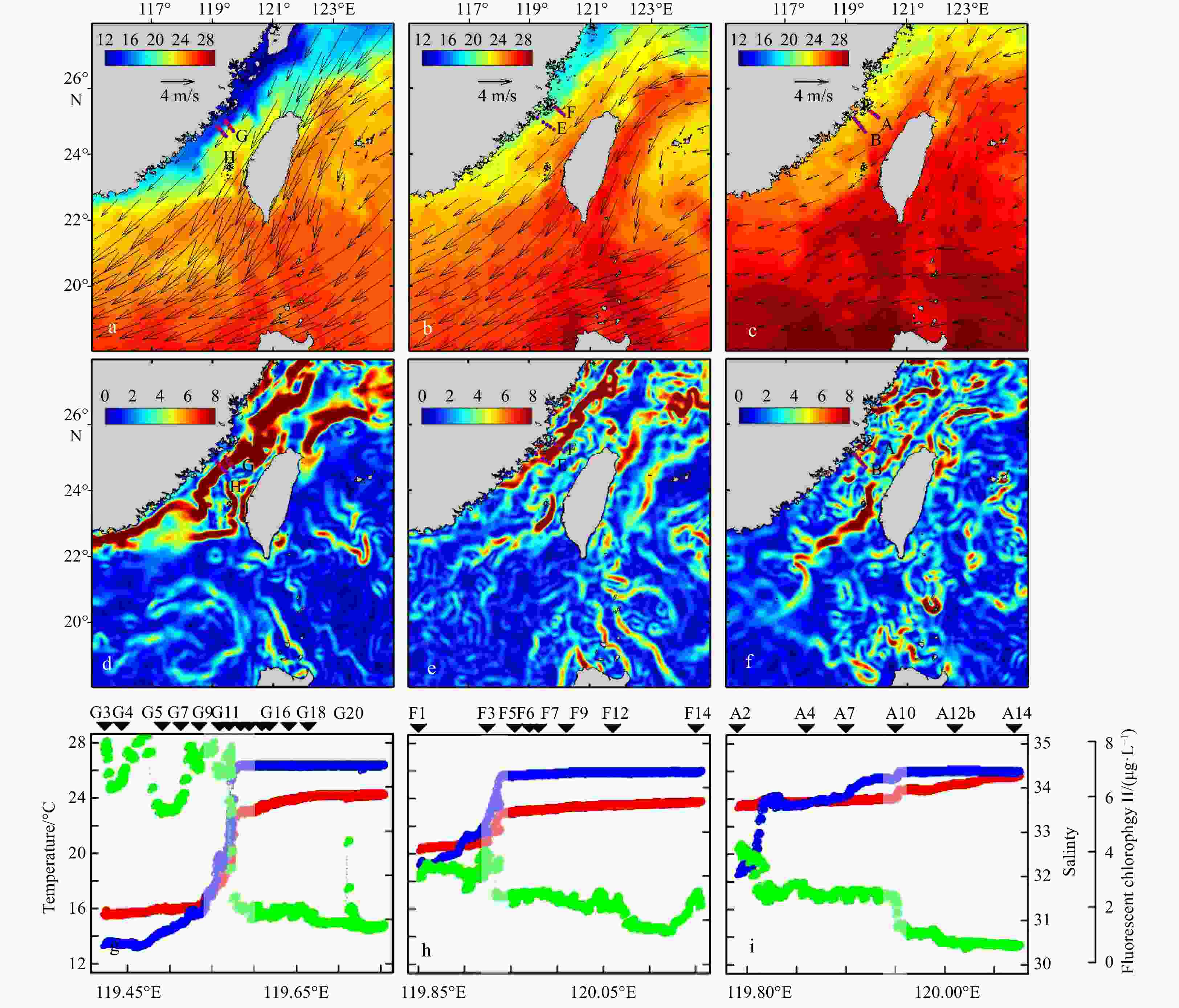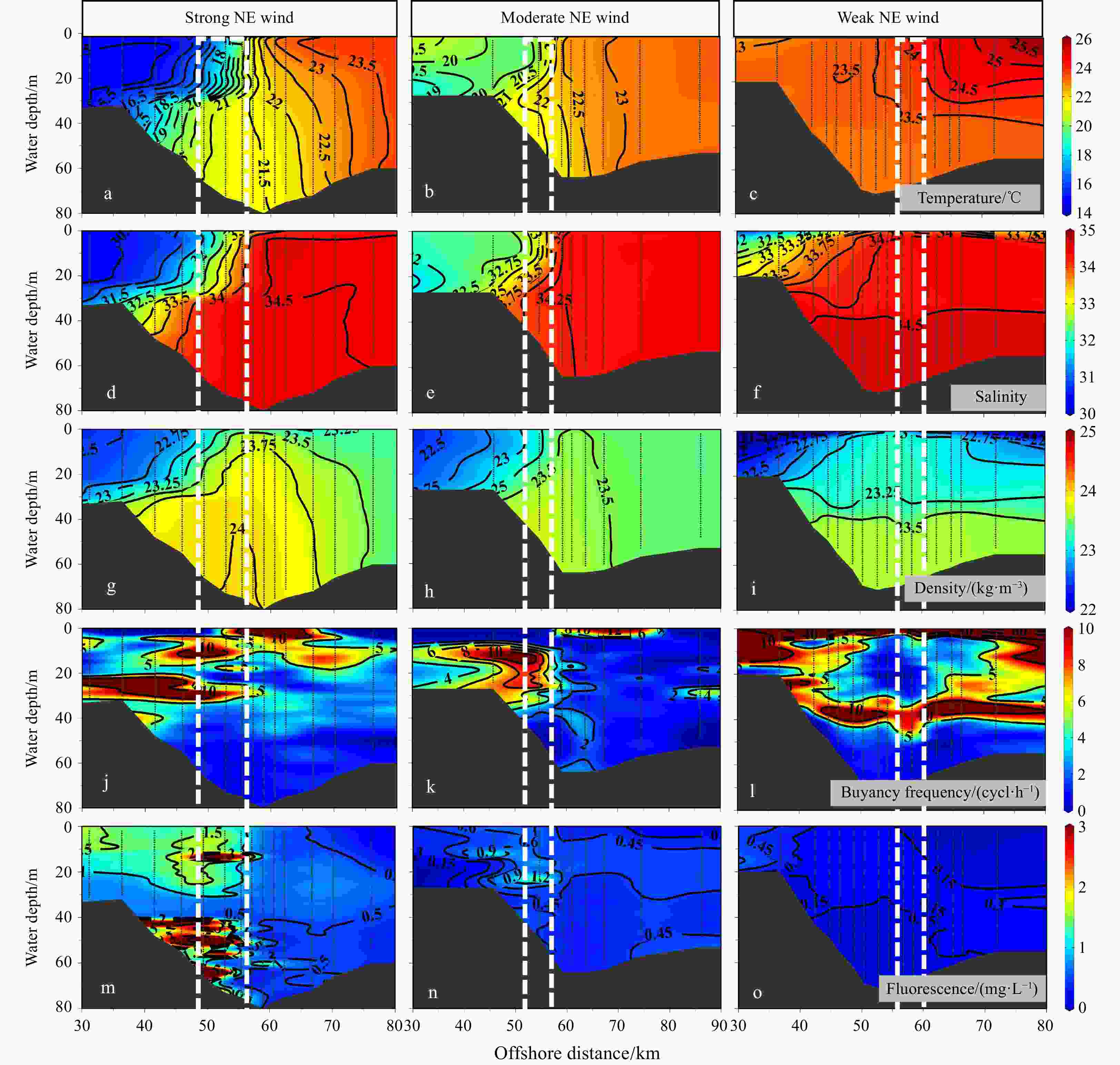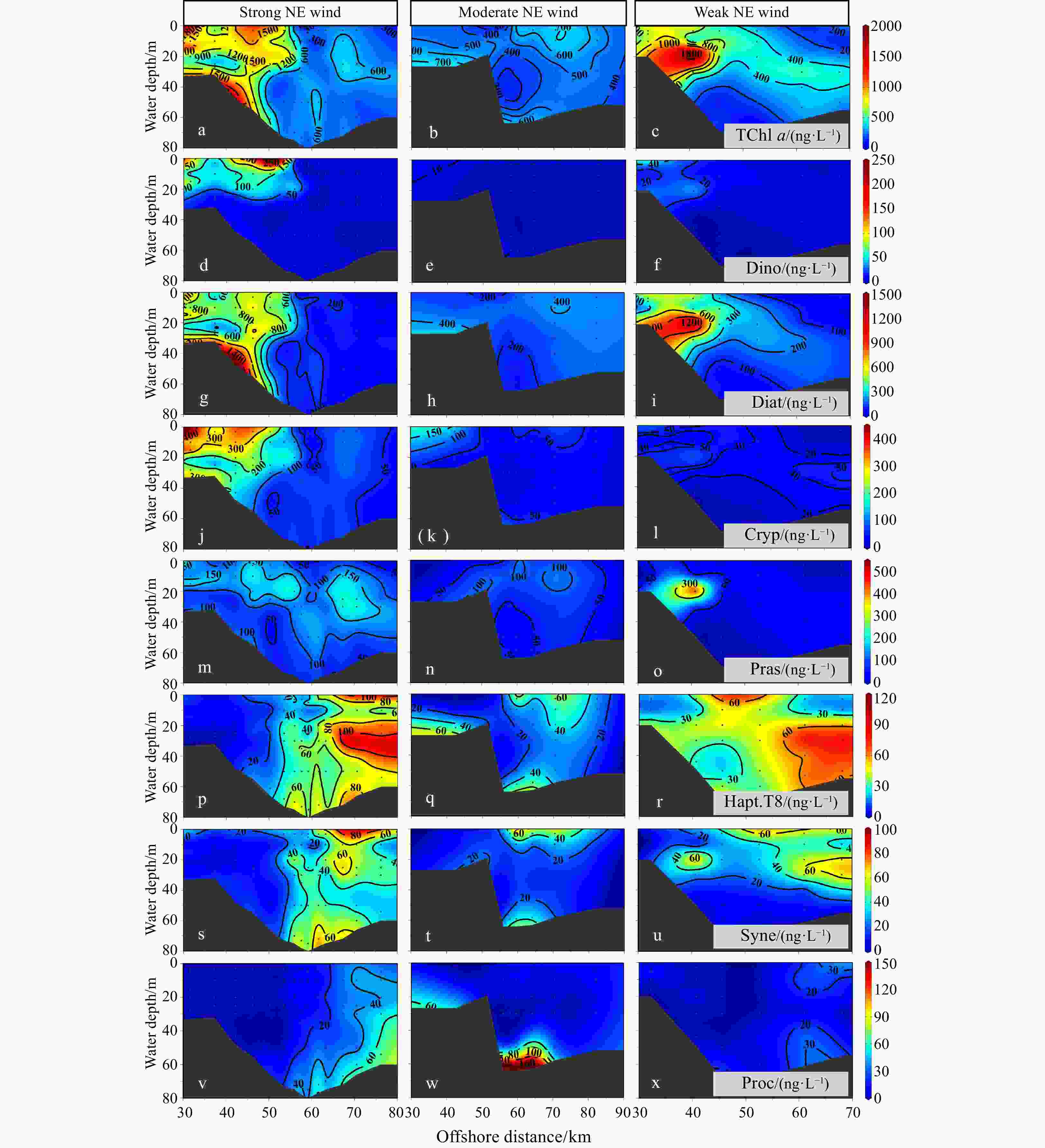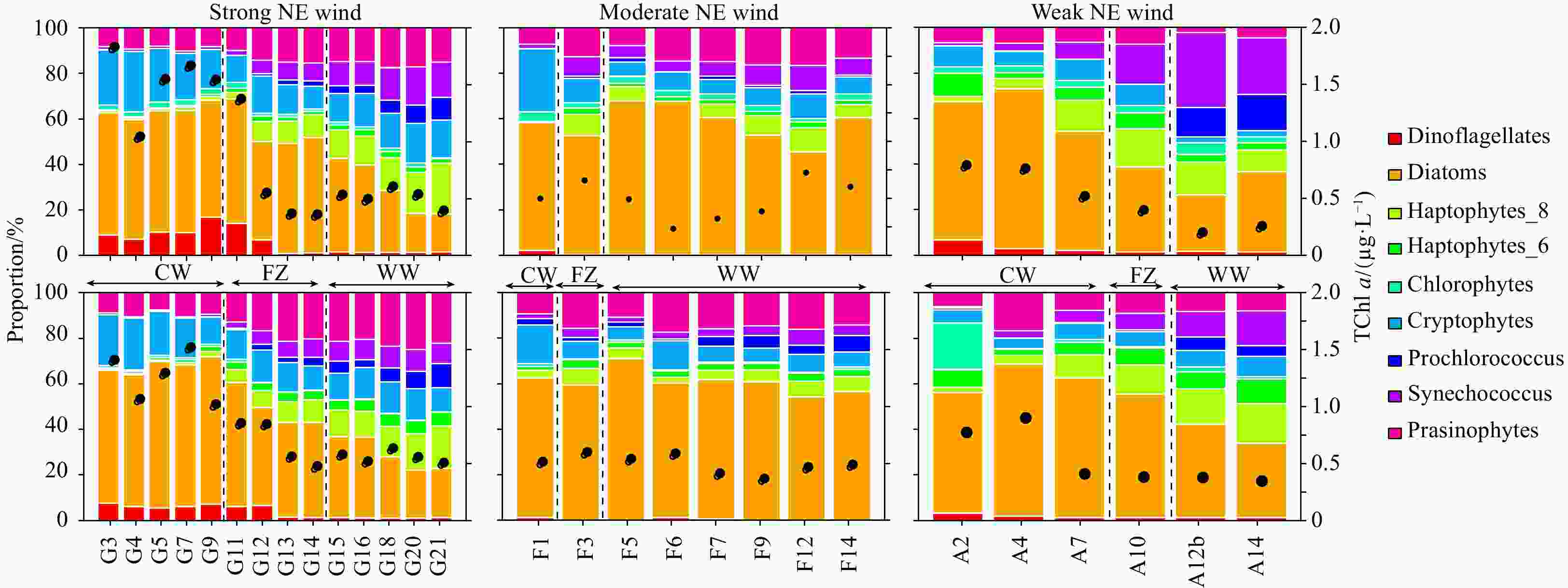Dynamic of phytoplankton community during varying intensities of the northeast monsoon in the Taiwan Strait
-
Abstract: The characteristics of the terrain of a strait can lead to a “fine tube” effect that enhances a monsoon and thereby affects the physical, chemical, and biological processes of marine ecosystems. This effect is a highly dynamic and complex phenomenon involving interactions among atmospheric, oceanic, and terrestrial systems, as well as biogeochemical cycles and biological responses driven by it. However, current understanding has been focused mainly on the differences between monsoons, and there have been few studies concerned with the weakening or strengthening of monsoons. To explore the biogeochemical and phytoplankton responses during varying intensities of the northeast (NE) monsoon in the Taiwan Strait (TWS), high-resolution, across-front observations combined with FerryBox online data and satellite observations were conducted in this study during a strong, moderate, and weak NE monsoon. The spatiotemporal changes of nutrient concentrations and phytoplankton communities were regulated by the dynamics of ocean currents forced by NE winds. The weakening of the NE monsoon caused shrinkage of the coastal currents that led to a reduction of nutrient concentrations and an alteration of the distribution patterns of phytoplankton communities along cross-front sections. Specifically, there was a notable decrease in the proportions of dinoflagellates and cryptophytes in inshore regions and of prasinophytes in offshore areas. This study showed for the first time the dynamics of phytoplankton with changes of ocean currents during varying intensities of the NE monsoon in a strait system. The findings helped to elucidate the general spatial patterns of the phytoplankton community based on satellite-derived surface temperature and wind patterns and further enhanced the understanding of biogeochemical cycles in marine systems.
-
Key words:
- onsoon /
- coastal current /
- front /
- phytoplankton community /
- Taiwan Strait
-
Figure 1. The mean sea surface temperature (℃, a-e), wind velocity at 10 m above the sea surface (vectors, in m/s, a-e), the horizontal gradient of temperature (℃/100 km, f-j) and chlorophyll a (k-o) in the Taiwan Strait in January (a, f, k), February (b, g, l), March (c, h, m), April (d, i, n), May (e, j, o) between 2010 and 2022. The blue and black lines represent the 17℃ and 20℃ isotherms.
Figure 2. Averaged SST (shading, in ℃) during the observations in March 2019 (a), April 2018 (b), and May 2017 (c) and averaged wind velocity at 10 m above the sea surface (vectors, in m/s, a-c) in the Taiwan Strait before two weeks of the observations in March 2019 (a), April 2018 (b), and May 2017 (c); The horizontal gradient of temperature (℃/100 km) in the Taiwan Strait during observations with strong (d), moderate (e), and weak (f) NE wind; Changes of temperature, salinity, and fluorescent chlorophyll along Transects G, F, and A during the cruises of 2019 (g), 2018 (h) and 2017(i). The grey rectangles represent the frontal zones.
Figure 4. Vertical profiles of sea temperature (℃, a, b, c), salinity (d, e, f), potential density anomaly (kg/m3, g, h, i), buoyancy frequency (cycl/h, j, k, l), and fluorescence (μg/L, m, n, o) along Transects G (a, d, g, j, m), F (b, e, h, k, n), and A (c, f, i, l, o) under the forcing of strong, moderate, and weak NE wind. Stations in white frames represent the frontal zones.
Figure 6. Vertical profiles of total ChlorophyII a (TChl a)(ng/L, a, b, c), dinoflagellate (Dino, ng/L, d, e, f), diatoms (Diat, ng/L, g, h, i), cryptophytes (cryp, ng/L, j, k, l), prasinophytes (Pras, ng/L, m, n, o), haptophytes type 8 (Hapt. T8, ng/L, p, q, r), Synechococcus (Syne, ng/L, s, t, u), and Prochlorococcus (Proc, ng/L, v, w, x) along the Transects G, F, and A under the forcing of strong, moderate, and weak NE wind.
Figure 8. Principal coordinates analysis (PCoA) based on the Bray-Curitis dissimilarities of the phytoplankton community in different zones (left), and canonical correlation analysis (CCA) of phytoplankton community and environmental factors. CW: coastal water; FZ: the frontal zone; WW: the warm water
Figure 9. The ecological responses to the various ocean currents with the weakening of the NE wind in the TWS. (a) It represents the ecological responses to the strong NE wind, when the western TWS was influenced by the large influence of the coastal currents; (b) It represents the ecological responses to with the weakening of NE wind, when the western TWS was less influenced by the coastal currents.
-
Belkin I M, Cornillon P C, Sherman K. 2009. Fronts in large marine ecosystems. Progress in Oceanography, 81(1-4): 223–236, doi: 10.1016/j.pocean.2009.04.015 Brandini F P, Tura P M, Santos P P G M. 2018. Ecosystem responses to biogeochemical fronts in the South Brazil Bight. Progress in Oceanography, 164: 52–62, doi: 10.1016/j.pocean.2018.04.012 Chen Yuhan, Lin Heyun. 2022. Overview of the development of offshore wind power generation in China. Sustainable Energy Technologies and Assessments, 53: 102766, doi: 10.1016/j.seta.2022.102766 Clayton S, Nagai T, Follows M J. 2014. Fine scale phytoplankton community structure across the Kuroshio Front. Journal of Plankton Research, 36(4): 1017–1030, doi: 10.1093/plankt/fbu020 Dang Xiaoyan, Bai Yan, Gong Fang, et al. 2022. Different responses of phytoplankton to the ENSO in two upwelling systems of the South China Sea. Estuaries and Coasts, 45(2): 485–500, doi: 10.1007/s12237-021-00987-2 Flint M V, Sukhanova I N, Kopylov I, et al. 2002. Plankton distribution associated with frontal zones in the vicinity of the Pribilof Islands. Deep-Sea Research Part II: Topical Studies in Oceanography, 49(26): 6069–6093, doi: 10.1016/S0967-0645(02)00334-X He Shuangyan, Huang Daji, Zeng Dingyong. 2016. Double SST fronts observed from MODIS data in the East China Sea off the Zhejiang–Fujian coast, China. Journal of Marine Systems, 154: 93–102, doi: 10.1016/j.jmarsys.2015.02.009 Hong Huasheng, Chai Fei, Zhang Caiyun, et al. 2011a. An overview of physical and biogeochemical processes and ecosystem dynamics in the Taiwan Strait. Continental Shelf Research, 31(6): S3–S12, doi: 10.1016/j.csr.2011.02.002 Hong Huasheng, Liu Xin, Chiang Kuo-Ping, et al. 2011b. The coupling of temporal and spatial variations of chlorophyll a concentration and the East Asian monsoons in the southern Taiwan Strait. Continental Shelf Research, 31(6): S37–S47, doi: 10.1016/j.csr.2011.02.004 Hu Jianyu, Kawamura H, Li Chunyan, et al. 2010. Review on current and seawater volume transport through the Taiwan Strait. Journal of Oceanography, 66(5): 591–610, doi: 10.1007/s10872-010- 0049-1 Huang Ting-Hsuan, Chen Chen-Tung Arthur, Zhang Wenzhou, et al. 2015. Varying intensity of Kuroshio intrusion into Southeast Taiwan Strait during ENSO events. Continental Shelf Research, 103: 79–87, doi: 10.1016/j.csr.2015.04.021 Kuo Nan-Jung, Ho Chung-Ru. 2004. ENSO effect on the sea surface wind and sea surface temperature in the Taiwan Strait. Geophysical Research Letters, 31(13): L13309, doi: 10.1029/2004GL020303 Lai Chao-Chen, Wu Chau-Ron, Chuang Chia-Ying, et al. 2021. Phytoplankton and bacterial responses to monsoon-driven water masses mixing in the Kuroshio off the east coast of Taiwan. Frontiers in Marine Science, 8: 707807, doi: 10.3389/fmars.2021.707807 Li Qian, Franks P J S, Ohman M D, et al. 2012. Enhanced nitrate fluxes and biological processes at a frontal zone in the southern California current system. Journal of Plankton Research, 34(9): 790–801, doi: 10.1093/plankt/fbs006 Lv Ting, Liu Dongyan, Zhou Peng, et al. 2022. The coastal front modulates the timing and magnitude of spring phytoplankton bloom in the Yellow Sea. Water Research, 220: 118669, doi: 10.1016/j.watres.2022.118669 Mascioni M, Almandoz G O, Cusick A, et al. 2023. Phytoplankton dynamics in nearshore regions of the western Antarctic Peninsula in relation to a variable frontal zone in the Gerlache Strait. Frontiers in Marine Science, 10: 1139293, doi: 10.3389/fmars.2023.1139293 Mendes C R B, Tavano V M, Dotto T S, et al. 2018. New insights on the dominance of cryptophytes in Antarctic coastal waters: a case study in Gerlache Strait. Deep-Sea Research Part II: Topical Studies in Oceanography, 149: 161–170, doi: 10.1016/j.dsr2.2017.02.010 Oziel L, Baudena A, Ardyna M, et al. 2020. Faster Atlantic currents drive poleward expansion of temperate phytoplankton in the Arctic Ocean. Nature Communications, 11(1): 1705, doi: 10.1038/s41467-020-15485-5 Pan Aijun, Wan Xiaofeng, Guo Xiaogang, et al. 2013. Responses of the Zhe-Min coastal current adjacent to Pingtan Island to the wintertime monsoon relaxation in 2006 and its mechanism. Science China Earth Sciences, 56(3): 386–396, doi: 10.1007/s11430-012-4429-9 Parab S G, Matondkar S G P, do R. Gomes H, et al. 2006. Monsoon driven changes in phytoplankton populations in the eastern Arabian Sea as revealed by microscopy and HPLC pigment analysis. Continental Shelf Research, 26(20): 2538–2558, doi: 10.1016/j.csr.2006.08.004 R Core Team. 2020. R: A language and environment for statistical computing. Vienna, Austria: R Foundation for Statistical Computing. Ruiz S, Claret M, Pascual A, et al. 2019. Effects of oceanic mesoscale and submesoscale frontal processes on the vertical transport of phytoplankton. Journal of Geophysical Research: Oceans, 124(8): 5999–6014, doi: 10.1029/2019jc015034 Schlitzer R. 2020. Ocean Data View, odv. awi. de. (查阅网上资料, 未找到本条文献信息, 请确认Schlitzer R. 2020. Ocean Data View, odv. awi. de. (查阅网上资料, 未找到本条文献信息, 请确认) Shang Shaoling, Zhang Caiyun, Hong Huasheng, et al. 2005. Hydrographic and biological changes in the Taiwan Strait during the 1997–1998 El Niño winter. Geophysical Research Letters, 32(11): L11601, doi: 10.1029/2005gl022578 Son S, Yoo S, Noh J H. 2006. Spring phytoplankton bloom in the fronts of the East China Sea. Journal of Ocean Science, 41(3): 181–189, doi: 10.1007/BF03022423 Stukel M R, Aluwihare L I, Barbeau K A, et al. 2017. Mesoscale ocean fronts enhance carbon export due to gravitational sinking and subduction. Proceedings of the National Academy of Sciences of the United States of America, 114(6): 1252–1257, doi: 10.1073/pnas.1609435114 Taylor A G, Goericke R, Landry M R, et al. 2012. Sharp gradients in phytoplankton community structure across a frontal zone in the California Current Ecosystem. Journal of Plankton Research, 34(9): 778–789, doi: 10.1093/plankt/fbs036 Thomson R E, Fine I V. 2003. Estimating mixed layer depth from oceanic profile data. Journal of Atmospheric and Oceanic Technology, 20(2): 319–329, doi: 10.1175/1520-0426(2003)020<0319:EMLDFO>2.0.CO;2 Woodson C B, Litvin S Y. 2015. Ocean fronts drive marine fishery production and biogeochemical cycling. Proceedings of the National Academy of Sciences of the United States of America, 112(6): 1710–1715, doi: 10.1073/pnas.1417143112 Yu Yi, Xing Xiaogang, Liu Hailong, et al. 2019. The variability of chlorophyll-a and its relationship with dynamic factors in the basin of the South China Sea. Journal of Marine Systems, 200: 103230, doi: 10.1016/j.jmarsys.2019.103230 Zhang Caiyun, Huang Yan, Ding Wenxiang. 2020. Enhancement of Zhe-Min coastal water in the Taiwan Strait in winter. Journal of Oceanography, 76(3): 197–209, doi: 10.1007/s10872-020-00539-5 Zhao Zhonghua, Oey L Y, Huang Bangqin, et al. 2022. Off-coast phytoplankton bloom in the Taiwan Strait during the northeasterly monsoon wind relaxation period. Journal of Geophysical Research: Oceans, 127(9): e2022JC018752, doi: 10.1029/2022jc018752 Zhong Yanping, Hu Ju, Laws E A, et al. 2019. Plankton community responses to pulsed upwelling events in the southern Taiwan Strait. ICES Journal of Marine Science, 76(7): 2374–2388, doi: 10.1093/icesjms/fsz142 Zhong Yanping, Laws E A, Zhuang Jiafu, et al. 2022. Responses of phytoplankton communities driven by differences of source water intrusions in the El Niño and La Niña events in the Taiwan Strait during the early spring. Frontiers in Marine Science, 9: 997591, doi: 10.3389/fmars.2022.997591 Zhong Yanping, Liu Xin, Xiao Wupeng, et al. 2020. Phytoplankton community patterns in the Taiwan Strait match the characteristics of their realized niches. Progress in Oceanography, 186: 102366, doi: 10.1016/j.pocean.2020.102366 -

 点击查看大图
点击查看大图
计量
- 文章访问数: 147
- HTML全文浏览量: 58
- 被引次数: 0




 下载:
下载:









